How to roast pork: How to cook roast pork with crackling
How to roast pork - the simple way! This easy step-by-step recipe still make a delicious roast pork and the perfect Sunday lunch recipe
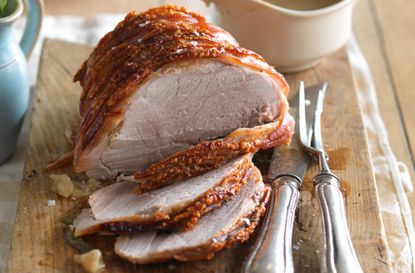

If you're wondering how to roast pork then you've come to the right place. Find out how long to cook roast pork, how to make pork crackling, and much more.
This simple step-by-step guide makes cooking roast pork easy. Packed with helpful advice on how to prepare and roast a whole joint of pork. We’ve included tips from our Test Kitchen experts – including their secrets to creating the perfect pork crackling.
Our roast pork guide includes advice on how to make a delicious apple gravy, which is the perfect match alongside this meaty joint of pork. We focus on cooking a classic pork leg joint, so see our other handy guides if you want advice on how to roast pork belly or how to cook pork chops instead.
The classic roast pork recipe that we refer to in this feature includes enough ingredients to serve around six people. If that’s too much for your gathering, don't worry as we also have loads of ideas on how to use up leftover pork too.
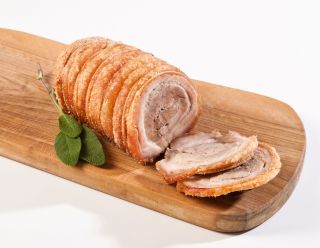
The best cut of pork for roasting
Pork leg, shoulder, or loin all make good joints for roasting. A piece of meat that’s been boned and rolled is easiest to carve, and you might want to consider investing in a sharp knife.
As, when roasting the pork, you’ll need to pierce the flesh. If the juices run clear, the pork is cooked; if it’s still pink, it needs cooking for longer. Generally, outdoor-reared, free-range pork has a thicker layer of fat, which keeps the meat moister during cooking.
Do you cover pork when roasting?
If you’re cooking a joint of pork, which has a fatty layer of skin you want to make into crackling, definitely do not cover your pork. It will make the skin soft and chewy.
Some joints of meat require covering to ensure that they do not dry out or brown too heavily. This isn’t a problem with roast pork because the fat keeps it lovely and moist and you want the top of the skin to crisp up. If you remove the skin to make crackling separately then you might want to cover the meat to stop it from burning at the end of cooking.
Once you have finished cooking the roast pork, you might want to cover it to keep it warm when resting. Resting is important because it makes the meat juicy and more succulent. We prefer to take the crackling off before covering it in foil so that any steam coming off the joint doesn’t cause the crackling to go soft.
How long does it take to cook a 1kg or 2kg joint of pork?
As a general rule of thumb, it takes 30-35mins per 500g plus around 30min on high at the beginning to cook a joint of pork. If you are used to lb rather than grams then 500g is just over 1lb. The high temperature at the beginning is important because it gives the crackling a good head start before cooking the meat.
1kg of a joint of pork will take 1hr to 1hr 10 minutes + 30 minutes high at the beginning 2kg will take 2 hr to 2hr 20 + 30 minutes high at the beginning
If you have a meat thermometer, check to ensure the pork is at least 75C. Other meats will not need to be as hot but it is very important that pork is cooked properly. The UK Food Standards Agency says; "Pork needs to reach an internal temperature of 75C for 2mins in order to kill off any harmful bacteria" Pork is safe to eat as long as you cook it properly.

What temperature should roast pork be cooked at?
Our Test Kitchen recommends that you give pork an initial heat blast at 220C/Gas 8 for 30mins before reducing the heat to 180C/Gas 4 for the rest of the roasting time (30mins per 500g/1lb). This is for pork roasting joints such as rolled shoulder, leg, or pork loin.
Some joints of pork, for example, pork belly, are cooked for much longer at the same temperature of 180C/Gas 4. Jamie Oliver cooks his pork belly for up to 1hr per kg but gives a slightly longer heat blast at the beginning - around 40-50mins. In Gordon Ramsay's honey glazed ham recipe he cooks his slow roast pork belly for 2.5hrs per kg with no heat blast.
If the skin hasn't become crispy by the end then you can put the heat up to 220C for a further 20-30mins but be careful not to overcook the meat. Our Deputy Food Editor, Rose, likes to remove the skin from the meat at the end and put the skin back in the oven on its own (while the meat rests) at a higher temperature to make sure it's super crisp.
[apester id="602cfabf06fa0e440799d1d8"]
How to make pork crackling
The key to crackling is to make sure the skin is super dry. You can achieve this in a number of ways. Deputy Food Editor, Rose Fooks, likes to store the joint in the fridge overnight after scoring the skin to really dry the skin out and then get it out an hour before cooking to ensure an even cook.
Food Director, Elisa, likes to pour boiling hot water over the skin before cooking then pat dry again with a tea towel before re-seasoning and roasting immediately. Our Food Editor, Samuel, is always careful when scoring the skin to ensure that he doesn't cut through to the meat which can release juices onto the skin and stop it from crisping up.
If the skin is struggling to get crispy then you can, as Rose does, separate the skin from the meat and cook it at a higher temperature whilst the meat rests.
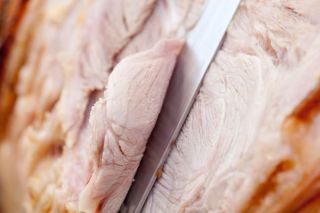
How to roast pork with crackling
Follow our step-by-step recipe below to make the perfect, succulent roast pork with crackling. We've also got a easy-to-follow video for your reference too, which you can see above.
Ingredients
- 2.3kg whole boneless pork leg joint, rolled
- 2 cloves garlic, peeled and thinly sliced
- 1-2tbsps sea-salt flakes
- 2 onions, peeled and sliced
- Handful of sage leaves
- 1 cooking apple
- 500ml pork stock
- 1tbsp plain flour
- Salt and freshly ground black pepper
How to roast pork: cut the skin
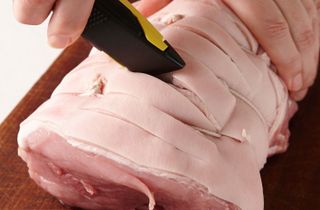
Use a craft knife to cut all the way through the pork skin to make parallel lines, cutting some additional lines to those made by the butcher, but taking care not to cut through the string so the joint doesn’t unroll. Our Food Editor, Samuel, says “it’s really important that you don’t cut all the way through the skin in to the meat or you will struggle to get really crispy crackling.’
How to roast pork: add flavour

Use a small knife to cut into the flesh and insert slices of garlic into the meat and under the skin. Elisa Roche, Food Director, advises to “pat the skin dry with a tea towel before you attempt to make good crackling and massage the herbs into the skin as if you were taking that pig to a spa. Carraway seeds are a also nice surprise with pork”
How to roast pork: Prep skin and leave to dry
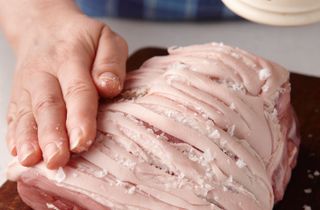
Rub the salt into the skin. If you have time, leave it in the fridge overnight (if you can), uncovered, for the skin to completely dry out. Deputy Food Editor, Rose, explains that it is important to “remove the meat from the fridge an hour before cooking so that it cooks evenly.”
How to roast pork: heat the oven and prep apple gravy

Set the oven to its highest setting. Spread the sliced onion and sage leaves out in a roasting tin. Quarter, peel and core the apple, cut into slices and scatter over the onions.
How to roast pork: cook the joint
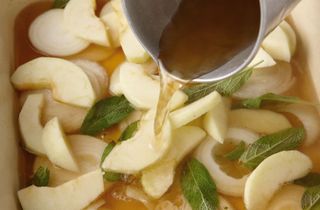
Pour in the stock. Place the pork on top. Roast it in the centre of the oven for about 25-30 mins, until the skin starts to crisp up, then reduce the oven temperature to 180°C/350°F/Gas Mark 4, and cook for a further 2-2¼ hours. Remove the meat from the oven. If the skin hasn’t formed a crackling our Deputy Food Editor, Rose, advises to “Cut the crackling off while you rest the meat and put it back in the top of the oven so it gets lovely and crispy.”
How to roast pork: Finish and serve
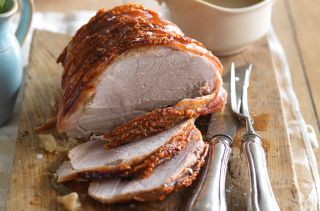
Transfer the pork to a warmed dish and leave it to rest for about 10-15 mins before slicing. Meanwhile, sprinkle the flour over the juices in the pan, then tip the juices into a jug, scraping as much from the bottom of the pan as possible, and use a stick blender to whizz until smooth (this may be done in a blender or food processor).
Return the mixture to a pan and bring it to the boil, stirring continually, and then simmer it for a few minutes to thicken slightly. If it’s too thick, add some boiling water. Season to taste, and serve with the meat.
Goodto Newsletter
Parenting advice, hot topics, best buys and family finance tips delivered straight to your inbox.

Former Assistant Headteacher, Samuel has a BSc in Food from the University of Birmingham and is also Co-Vice Chair of the Guild of Food Writers and a Trustee of 91 Ways CIC. His work has featured in national and international publications including Waitrose Food, Australian Delicious, and the LAD Bible Group. Samuel has also consulted on a number of best-selling food and drink books, and was a nutritional consultant for BBC’s Eat Well for Less.